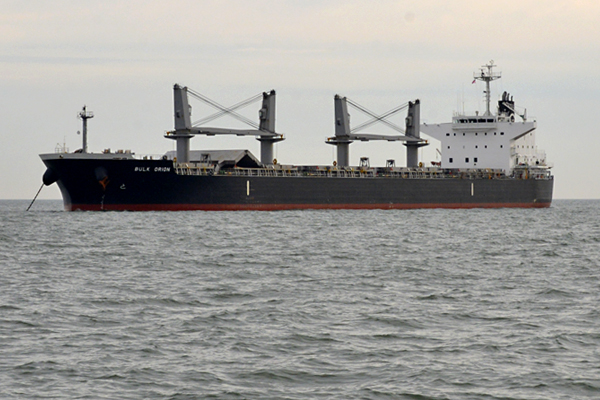


Environmental trade-offs, opportunities
Researchers examine market potential, environmental trade-offs of using natural gas as a marine fuel
2:52 p.m., Sept. 22, 2015--As the maritime shipping industry transitions toward cleaner fuels in response to new environmental regulations and emissions standards, abundant supplies of natural gas in the United States, and worldwide, appear to offer a promising solution in transportation industries.
Natural gas is considered by many to be a 21st century energy resource that will enable multiple sectors, including shipping, to transition away from petroleum fuels. But, questions remain about whether the economic and energy potential benefits include co-benefits for the environment.
Research Stories
Chronic wounds
Prof. Heck's legacy
The University of Delaware’s James Corbett, a professor of marine science and policy in UD’s College of Earth, Ocean, and Environment, has spent the past 15 years working to improve environmental policy on global shipping.
In a study published this week in the international journal Energy Policy, Corbett, in partnership with James Winebrake, a professor at Rochester Institute of Technology, and recent UD doctoral graduate Heather Thomson, evaluated whether a transition to using liquid natural gas (LNG) to power marine vessels can reduce both local pollution and greenhouse gas in the marine environment, and whether fueling ships at major ports can help develop the natural gas infrastructure.
Study findings indicate that while using natural gas will reduce emissions in the marine sector, the implications for greenhouse gases depends on how the natural gas is extracted, processed, distributed and used.
“Local and regional air pollution benefits of liquefied natural gas are a slam-dunk over traditional marine fuels, and the long run price of LNG looks to be advantageous. But LNG was not a clear winner for climate change with regard to greenhouse gas implications, especially if the fuel supply infrastructure is not designed to minimize natural gas losses,” Corbett said.
The findings have important energy policy implications as the shipping industry, for the first time, comes under regulations that will change its real behavior with regard to pollution.
New maritime regulations require ships operating within 200 miles of the U.S. coast to reduce sulfur emissions. In 2016, additional regulations will require exhaust treatment to reduce nitrogen oxide emissions in new vessels.
At the same time, the availability of large domestic reserves of gas from U.S. shale fields has dropped the price of LNG below diesel and extended the market for gas into diesel-engine domains such as marine vessels and railroads. If prices stay stable, switching to liquefied natural gas could be an investment that saves shipping company’s money over the lifetime of their fleet.
“Our purpose is to help policymakers assess the potential impacts of energy and environmental policies aimed at improving air quality, reducing greenhouse gas emissions, and moving toward non-petroleum based fuels like natural gas,” Corbett said.
Advancing the research approach
According to Corbett, a successful transition to LNG will require a carefully constructed infrastructure development policy that requires state-of-the-art infrastructure that minimizes leakage at the earliest stages of the fuel cycle.
The researchers used an advanced method known as a “technology warming potential” (TWP) approach to analyze the life cycle of LNG production and delivery over three case studies.
“Assessing the ‘technology warming potential’ of a fuel transition addresses inherent problems with the more traditional ‘global warming potential comparison,’” said Winebrake. “Our approach uses TWP in a more realistic analysis whereby diesel powered vessels are replaced by natural gas vessels that create emissions over their useful lifetime.”
The researchers are among the first to compare technology warming potential with traditional methods used to measure how good or bad a fuel is based on greenhouse gas comparisons.
The case studies represented typical marine vessel trips in the following categories: local, regional and long haul cargo transportation. For each case study, the scientists compared LNG to commercial marine diesel fuels traditionally used in the industry.
The approach accounted for emissions of nitrogen oxides, sulfur oxides and particulate matter in each case, while also quantifying and comparing greenhouse gas emissions including carbon dioxide, methane and nitrogen oxides. The scientists also considered regional drivers that might influence the adoption of natural gas as a marine fuel.
This study considers the entire lifecycle, from the extraction of natural gas from the ground to the production of LNG to its ultimate use, providing a more complete accounting of the co-benefits or trade-offs of energy policy decisions related to ship fuel choices and natural gas development.
The study finds that natural gas in marine engines may reduce greenhouse gases (lower technology warming potential) under certain conditions and timeframes. However, these conditions depend upon low-greenhouse gas LNG infrastructure and advanced combustion technologies to reduce methane leakage.
Developing sustainable natural gas infrastructure
Other important considerations include the conditions that may favor converting marine transportation systems to natural gas.
This work is supported in part through ongoing funding from the U.S. Department of Transportation Maritime Administration (MARAD), which supported this study because conditions favor expanded natural gas use in North America and because ship operators are looking at natural gas as a clean fuel to meet environmental standards. Some companies in the U.S., like TOTE, are converting a portion of the ships in their fleet to natural gas (LNG) in order to weigh its advantages.
MARAD has also been studying the necessary infrastructure to enable vessel fueling and operations that may provide LNG to ships in U.S. ports.
“This study is an important example of how the U.S. Maritime Administration supports research to address maritime environmental issues and overall feasibility of using natural gas as a marine propulsion fuel,” commented Dan Yuska from MARAD’s Maritime Environmental Technical Assistance (META) Program.
While a global conversion to LNG in maritime transport is unlikely in the near term, the pace of development depends on regional motivation to develop supply and delivery systems.
“Our work shows the need for investments in a low leakage infrastructure, and further innovations by engine manufacturers to capture and prevent the release of methane during engine operation, in order to ensure greenhouse benefits to switching to LNG accompany the air pollution and economic benefits,” Corbett said.
Article by Karen B. Roberts
Photo of tanker by Lisa Tossey
Photo of James Corbett by Evan Krape









